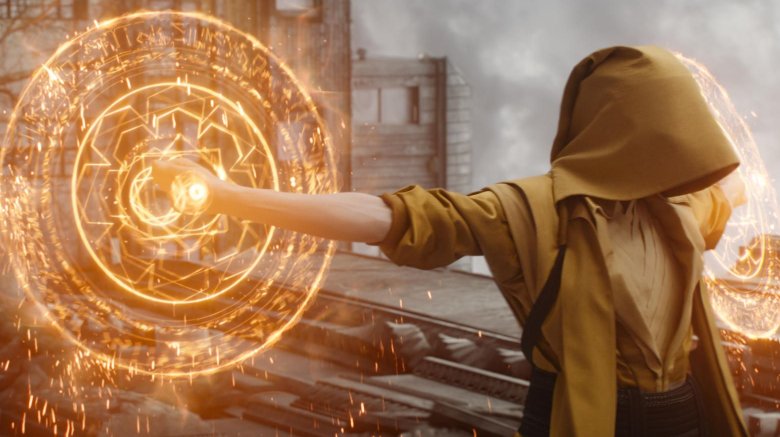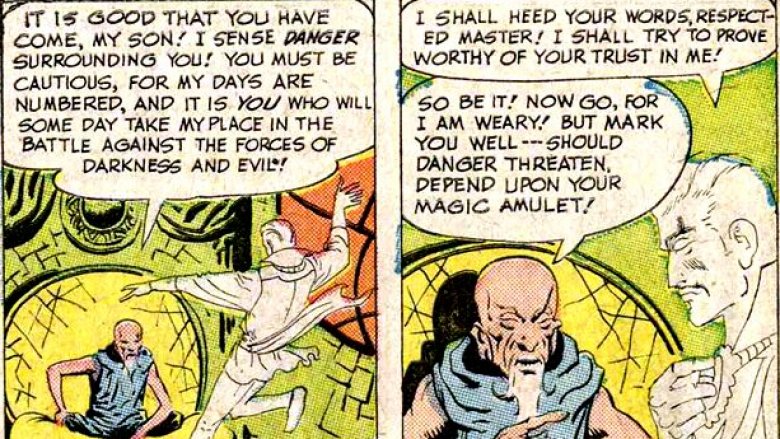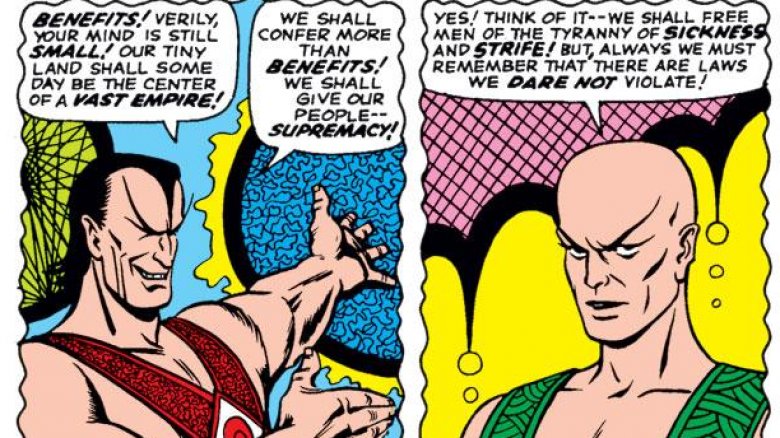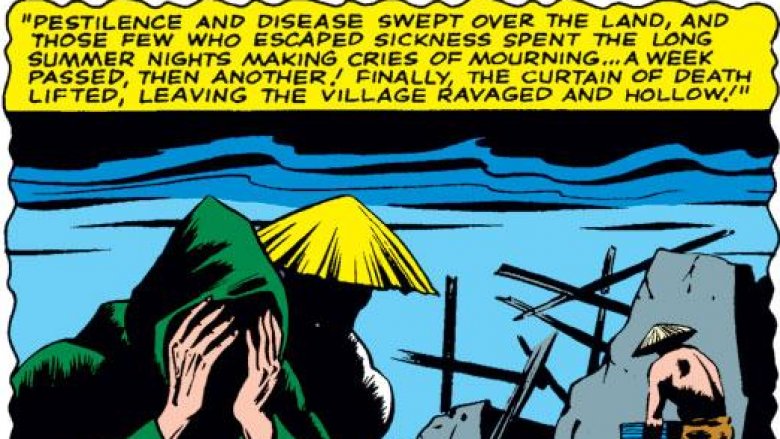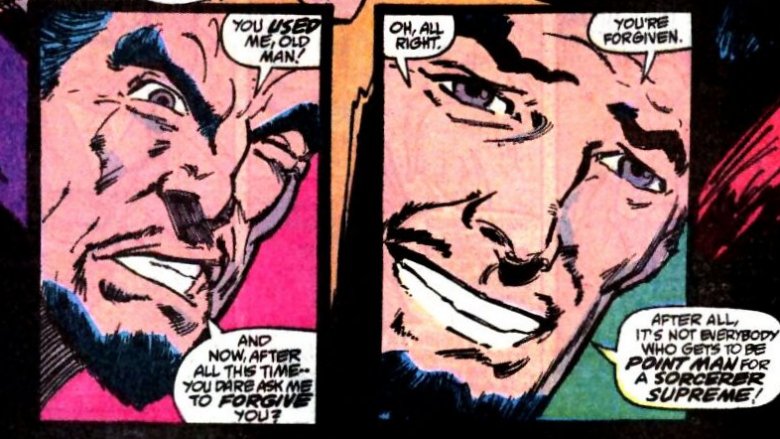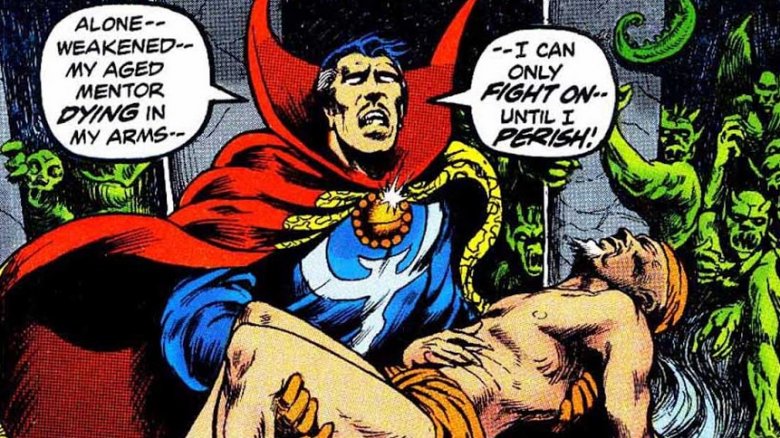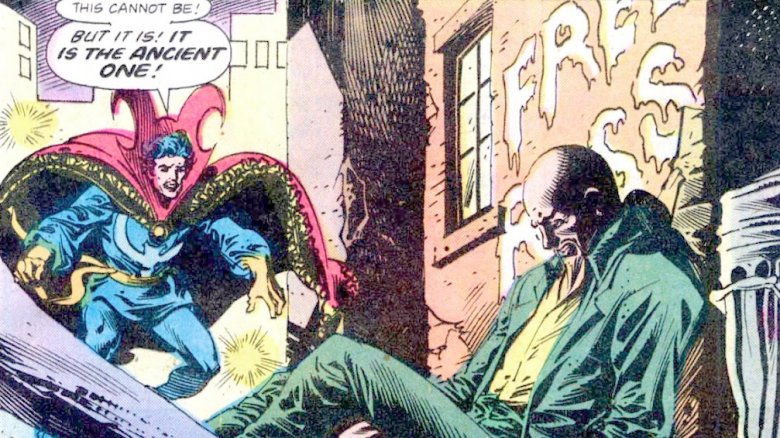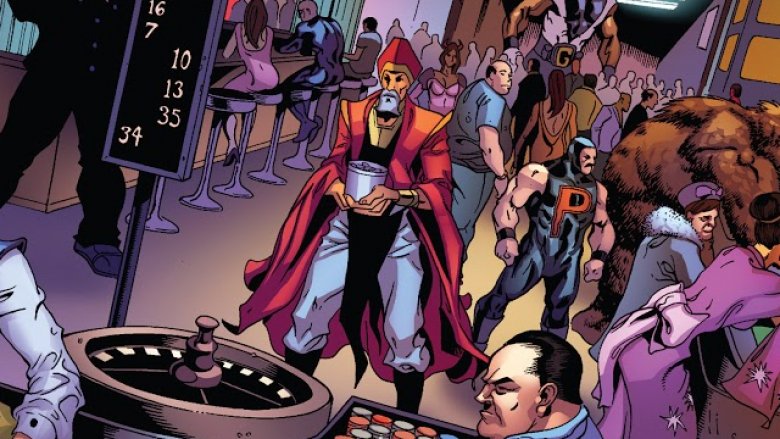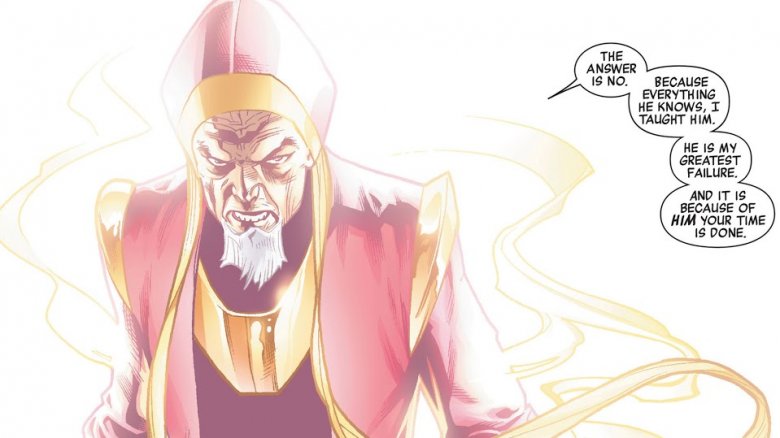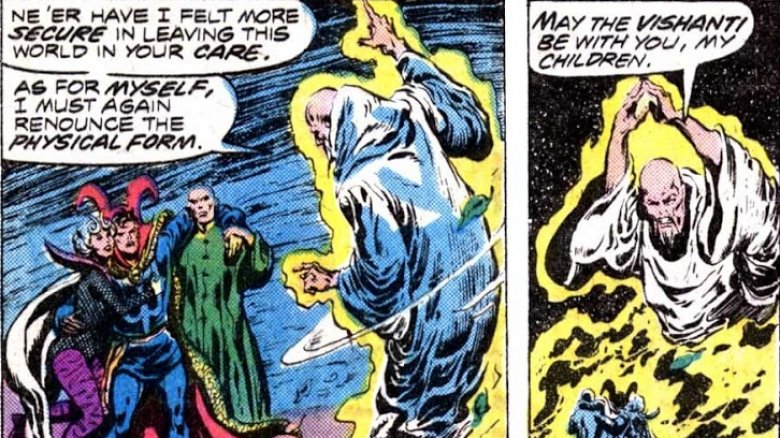The Untold Truth Of The Ancient One
In the wake of his eponymous movie and subsequent world-saving appearances in Avengers: Infinity War and Avengers: Endgame, Doctor Strange is riding high. The world knows his name, his powerset, and his mission. People on the street have heard of his manservant Wong, and as of Infinity War, even know his favorite ice cream flavor, Hulk-a-Hulk-a-Burnin'-Fudge (as Stark Raving Hazelnuts is "a bit chalky"). The Eye of Agamotto is in toy chests the world over, and Kamar-Taj has made an appearance on the silver screen. It's Marvel-mania at its most mystical.
But Doctor Strange is no one without the Ancient One. A nameless mystic who has seen hundreds of eras, rulers, and ways of life rise, plateau, and fall, the Ancient One, in every incarnation of Doctor Strange, is his mentor. The character is now known for Tilda Swinton's gender-swapped portrayal in the MCU, but he has decades of comic-book history that predate her offbeat incarnation. Here, we delve into the man behind the Master of the Mystic Arts, the one who started it all and just can't seem to stay dead, Kamar-Taj's favorite son: the one and only Ancient One.
He's been part of Doctor Strange's story from the very beginning
A lot of the most classic characters in comics aren't as old as we think they are. Storm, for example, is a perennial part of the X-Men's adventures, defeats, and shake-ups, yet she was introduced decades after the first X-Men comic hit the stands. It's almost rare, really, that the iconic parts of a superhero's world are present from the beginning — more typically, locations, powers, and supporting figures come and go as the years wind on, with only a few retained and remembered.
Not so with the Ancient One. He's been part of Doctor Strange's coterie and a ceaseless source of wisdom and arcane plot developments from the very beginning. He made his debut in the very same issue Doctor Strange did, in fact: Strange Tales #110, released in 1963. Approached by a man with terrible dreams, Strange visits "the Master, from whom all my powers stem" in metaphysical form. The Ancient One, alone in a hidden temple somewhere in "the remote vastness of Asia," warns Strange that the time is nearing in which Strange must step up to "the battle against the forces of darkness and evil." Strange thanks him for his guidance, and thus their relationship is established: old man and young, teacher and pupil, a sorcerer and his successor.
He wasn't born magical
For a very long time, all we knew about the Ancient One amounted to his first appearance. He was old, he was powerful, and he kept to a lonely part of the world where curious seekers of magic sought him out for instruction. But in 1966, Stan Lee and Denny O'Neill plumbed the depths of his fathomless soul in Strange Tales #148, "The Origin of The Ancient One!"
It turns out that the Ancient One wasn't born magical. Five hundred years in the past, he was a simple farmer of Kamar-Taj, "a hidden land high in the Himalayas... populated by a race of people who, though not outwardly advanced, had developed the arts of joyous living to a degree undreamed of by more complex civilizations." But this Edenic splendor wasn't enough for the unnamed youth who would become the Ancient One, nor his friend Kaluu. Together, they would delve into the supernatural — one towards beatific enlightenment, the other towards sinister domination. Five hundred years later, the Ancient One and Kaluu would once again meet, this time to do battle in a settling of ancient scores. Good thing only one of them had Doctor Strange on his side.
He destroyed the original Kamar-Taj
The Ancient One's backstory isn't all grimoire-riffling and Himalayan hijinks, however. Like any main character in a superhero story, his power was gained at a terrible cost — one that haunts him every day, even five hundred years after the fact. In experimenting with powers they did not fully understand, the Ancient One and Kaluu unearthed abilities that made them nigh-godlike. The Ancient One, delighted, celebrated the fact that he and Kaluu were now able to "free men from the tyranny of sickness and strife" — but Kaluu saw no need to stop there. He, instead, saw a way to make Kamar-Taj into the center of a vast and powerful empire that he would command as sorcerer-king.
Despite the Ancient One's protestations, Kaluu bent Kamar-Taj to his will using hypnosis, and in his haste to fix things, the Ancient One brought all his mystic might down upon his former friend. In so doing, he broke Kaluu's grip upon the people, but also the people themselves. Kamar-Taj was destroyed by the Ancient One's own hand, and the Ancient One was deprived of true immortality, left instead with dramatically slowed aging. He set out into the world, dedicated anew to the study of magic and its use in the prevention of evil, haunted eternally by the destruction of his homeland.
Doctor Strange wasn't his first superheroic student
Before Doctor Strange, there was another. This is true in both an in-universe and a metatextual sense: Doctor Druid, formerly known as Doctor Droom, predates Strange's publication by a few years and served as one of the Ancient One's prior students. A righteous hunter of magical mayhem-makers, Druid is, like Strange, a doctor, albeit one of psychiatry instead of medicine. He uses magic in his practice in the form of telepathy and hypnosis, and seeks to root out the arcane and occult forces that besiege the mundane world through his particular blend of Celtic might and modern therapy.
Much of his expertise was gained through a Tibetan Lama, who, having summoned Druid to his home in the Himalayas, instructed him in merging "the power of the ancient Britons with [his] Eastern knowledge." Avengers Spotlight #37 revealed that this Lama was, in fact, the disguised Ancient One, training Druid as Strange's precursor. Initially, Druid is angered by this revelation. But the Ancient One makes a strong case for his actions: he had to know if it was possible to transfer his powers to Strange when the time came, and he couldn't know that without practice. Doctor Druid might not have his own movie, but he does have a special place in the history of Doctor Strange and the Ancient One.
He died at the hands of a cosmic monster
Can the Ancient One die? One would assume he could, especially since, as we've established, true immortality was taken from him. We saw his MCU incarnation do it. We've seen similarly powerful Marvel figures do it. The answer eventually came, and it stands as a resounding "sort of?"
The thing is, death is funny in comic books, and funnier still if one's powers traverse the mortal planes. What is "death" to a person who has lived five hundred years and regularly traipses off to dimensions unknown? The closest the Ancient One has come is in a 1973 Marvel Premiere storyline, in which the eldritch being known as Shuma-Gorath invades the Ancient One's mind. The Ancient One commands Doctor Strange to destroy his ego, thus condemning him to death while trapping Shuma-Gorath and saving the world. So he dies... in a manner of speaking. A spectral version of him informs a grieving Strange that he is "more than alive now," and that Strange will understand someday. That goes for the audience as well.
He once came back to life as a drunken bum
In true comic book fashion, death — or "death," in this case — wasn't the end for the Ancient One. No, he's returned more than once to the corporeal world, but the first time was ignominious indeed. In "The Return of the Ancient One!" a storyline chronicled in 1977's Doctor Strange #26 through #28, the Ancient One does indeed return... as a down-on-his-luck drunk, using his magic to ensure an ever-flowing supply of alcohol.
Alerted to his mentor's return by a sudden surge in cosmic power, Strange goes to the Bowery and discovers the Ancient One in an alley, casting petty spells on those who intrude upon his sloshed stupor. It turns out that Strange's previous battle, in which he stopped the reality-bending machinations of a group of wizards called the Creators, yanked the Ancient One from his eternal rest in a "soul shattering" transformation. Disoriented, he took refuge in a mortal shell and drank to dull the shock of his rude awakening and maintain his powers.
Naturally, Doctor Strange saves the day and the Ancient One is able to shuffle off the mortal coil once more, "to be one with the universe." But for a moment, he had to be mortal again — a despairing, all-too-human mortal without the power of the cosmos at his fingers. It's a lesson he and Strange never forget.
He was seen gambling for resurrection in the afterlife
Not even the afterlife proved restful in the long run, however. In Incredible Hercules #129, the titular strongman journeys to the underworld and finds it to be a grimy, pestilential casino — literally. Hades, lord of the dead, has allowed his domain to become a seedy den of gamblers, hucksters, and outright con men, because running it all was getting just a bit dull. Cerberus, three-headed hellhound of Hades, is part of a Siegfried-and-Roy-style stage show. Fallen heroes like Janet Van Dyne wile away the hours at slots and blackjack. This, we learn, is the modern incarnation of the Greco-Roman Erebus, a land somewhere between life and death, where those who have died but not quite accepted it gamble for the chance to be resurrected and give their lives a proper finish.
Though it is a literal part of the plot, it's a metatextual one as well, commenting on comics' revolving-door approach to character death. Janet Van Dyne, for example, exclaims that if "they let Bucky out... the odds for [her] have got to be good, right?" In the midst of it all is the Ancient One, toting a bucket of poker chips over a gaming table at which Marvel heroes including Banshee and Blink sit, ready to turn their luck around. Given how many superheroes just can't manage to stay dead, it's likely the safest bet anyone in the Marvel Universe can make.
Agamotto once impersonated the Ancient One to try and get his Eye back
It seemed, for a while, that the Ancient One did manage to make it back to the land of the living — and he was not happy about it. In 2010's New Avengers run, dimensional invaders are swarming New York, Iron Fist has been transported to a void narrated by a formless voice, and just when all seems lost, who should materialize but the Ancient One, clad in his signature robes. But he isn't there to save the day. "[Strange] is my greatest failure," he proclaims, striding towards Iron Fist, a scowl on his elderly face, "and it is because of him your time is done."
Iron Fist returns to New York in a seething rage, full of what the Ancient One has told him about Doctor Strange and his allegedly evil plans. He claims that the Ancient One revealed that Strange stole the Eye of Agamotto from him, and that it is his mismanagement of the item that has placed the world in peril. A terrible battle ensues, and Strange is laid low with doubt. How could the Ancient One be so disappointed in him? How could he have lied to Iron Fist so sincerely? It turns out that the being who spoke to Iron Fist wasn't the Ancient One at all, but Agamotto himself. The sinister spirit is dispatched, and Doctor Strange regains his status as a true-blue hero and an ironclad Avenger.
The 2016 movie isn't his first time on the screen
With the world currently swamped with comic book adaptations of every stripe, it's only natural that some of the source material gets left behind. Sure, lots of people dive into the annals of Avengers comics after seeing the movies, and yes, decades of history and thousands of pages are nothing to sneeze at, even if they don't pull in billions of dollars. But the truth is that most people will know the Ancient One as an ageless Celtic woman played by Tilda Swinton.
But Swinton's isn't the only adaptation of the Ancient One out there. He's not just strode his way across screens large and small before, he's done it multiple times. The first came in 1978, as part of the failed pilot-turned-TV-movie Dr. Strange. Here, the Ancient One was a bodiless entity voiced by actor Michael Ansara, likely best known for playing Commander Kang in Star Trek. The Ancient One next appeared in the 1990s Spider-Man: The Animated Series, where he featured briefly in an episode appropriately titled "Doctor Strange." Most recently in animation, he was part of the 2007 Marvel animated feature Doctor Strange: Sorcerer Supreme.
Perhaps his most notable recent adaptation, however, comes from his place in the Marvel video games. In Marvel: Ultimate Alliance, he doesn't just appear as a fogged image in a mirror in Strange's Sanctum Sanctorum, he actually speaks with multiple characters. Too bad that one of them is Deadpool, who refers to him as "Grampy."
We've never learned his birth name
So, we've learned that the Ancient One is boundlessly powerful, to the point that not even death has much in the way of a hold on him. We've learned that he's so much a part of Strange's mythos that when the good doctor appears in cartoons, movies, or video games, the Ancient One typically shows up too. We've learned that his expertise came at a terrible price he can never truly repay. And we've learned that if you want to hurt Doctor Strange and fill his compatriots with doubt, there's no better way to do that than by impersonating the Ancient One and laying down some mentorly disapproval. He's a pillar of the Marvel universe, likely one of its most powerful denizens, and an evergreen source of story ideas.
What haven't we learned? His name. Despite the many aspects of the Ancient One that have changed with the times, from his gender to his clothing to his history, he has never been given a name. Presumably he once had one, if only when he was a simple man living in the bucolic fields of Kamar-Taj. But even in those pages that lay out his origins, we never learn it. Everything from the Marvel website to the Doctor Strange comics past and present refers to him only as "a youth" in the past and "the Ancient One" in the present. Whoever he was, he isn't any longer. And he's pretty okay with that.
